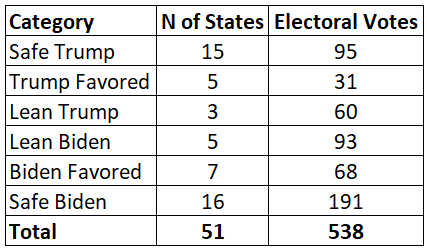State Polls Give Biden Strong Lead in Electoral College as First Debate Looms
A Commentary By Alan I. Abramowitz
KEY POINTS FROM THIS ARTICLE
— There is a strong relationship between the 2020 presidential polls in the states and the 2016 results.
— This relationship makes sense given that there is an incumbent on the ballot. In these kinds of elections, we see a very high degree of consistency in the results at the state level.
— There are enough competitive states for Donald Trump to come back and win, but Joe Biden is considerably closer to the magic number of 270 than Trump, based on the polls.
Biden v. Trump in the polls so far
An analysis of recent state polls shows that the Democratic challenger, Joe Biden, holds a solid lead over the Republican incumbent, Donald Trump, with a little more than a month to go until Election Day. Based on state polling data compiled by FiveThirtyEight through the morning of Sept. 25, Biden is leading in 20 states with 298 electoral votes while Trump is leading in 15 states with 154 electoral votes. There is insufficient polling data available for 15 states and the District of Columbia with 86 electoral votes.
An analysis of the data compiled by FiveThirtyEight indicates that there is an extremely strong relationship between the results of the 2016 presidential election and the 2020 polling results. The correlation between Hillary Clinton’s margin in 2016 and Biden’s current margin across these 35 states is a remarkable .985. However, this relationship is only slightly stronger than the .97 correlation between Barack Obama’s margin in the 2008 election and his margin in the 2012 election across all 50 states and the District of Columbia. In these elections with an incumbent running for a second term, we see a very high degree of consistency in the results at the state level.
Given this high degree of consistency, we can use the results of a regression analysis of Biden’s 2020 margin on Clinton’s 2016 margin in the states for which polling data is available to project Biden’s current margin in the remaining states. The estimated regression equation is:
PBM20 =.87*CM16 + 6.77 (PBM20 is Predicted Biden Margin in 2020 and CM16 is Clinton Margin in 2016).
Table 1 displays the estimates of Biden’s current margin in all 50 states and the District of Columbia based on the state polls in 35 states and projections for the remaining 15 states and the District of Columbia. For comparison purposes, the table also displays Hillary Clinton’s 2016 margin in each state. Based on the current polls and projections, Biden is leading in 27 states and the District of Columbia with 352 electoral votes while Trump is leading in 23 states with 186 electoral votes.[1]
Table 1: 2016 Clinton margin and predicted 2020 Biden margin in the states
Source: FiveThirtyEight and analysis of polling data by author. Based on public polling data through early Friday, Sept. 25.
The results displayed in Table 1 show that Biden is predicted to do better than Clinton in all 50 states with an average improvement in margin of about seven percentage points. The only place where Trump is predicted to improve on his 2016 margin is the District of Columbia. Crucially, Biden is outperforming Clinton by a substantial margin in several key swing states, outperforming her by seven points in Arizona, seven points in Michigan, eight points in Minnesota, five points in North Carolina, six points in New Hampshire, five points in Pennsylvania, and seven points in Wisconsin.
Of course, some of the predictions in Table 1 allow for much greater confidence than others. Based on the results of recent state polls and projections for states without adequate polling data, I classified states into six categories based on the size of Biden’s or Trump’s predicted margin. States in which a candidate’s current or projected margin is 10 points or more are classified as safe for that candidate. States in which a candidate’s current or projected margin is between five and 10 points are classified as favoring that candidate. Finally, states in which a candidate’s current or projected margin is less than five points are classified as leaning toward that candidate. The results are displayed in Table 2.
Table 2: Classification of state competitiveness based on polls and projections
Source: FiveThirtyEight and analysis of polling data by author.
The results in Table 2 show that 16 states with 191 electoral votes can be considered safe for Biden while 15 states with 95 electoral votes can be considered safe for Trump. Biden is clearly favored in another seven states with 68 electoral votes while Trump is clearly favored in five states with 31 electoral votes. Thus, based on these results, Joe Biden appears to have a clear advantage in 23 states with 259 electoral votes. In contrast, Donald Trump appears to have a clear advantage in 20 states with only 126 electoral votes.
Joe Biden is currently much closer than Donald Trump to reaching the goal of 270 electoral votes. However, neither candidate appears to have a lock on an Electoral College majority at this time. The winner ultimately will depend on eight swing states with 153 electoral votes where neither candidate currently has a decisive advantage. To reach 270 electoral votes, Joe Biden would only need to gain an additional 11 electoral votes, while Donald Trump would need to gain an additional 144 electoral votes from these states. Moreover, Biden is currently leading in five of these swing states with 93 electoral votes while Trump is only leading in three states with 60 electoral votes.
A look at the most closely contested states in the 2020 election according to the polls also indicates that there has been a marked shift in a Democratic direction since 2016. Several states that Donald Trump won easily in 2016 now appear to be up for grabs. Trump carried Iowa by nine points in 2016 but now leads by only one point. He carried Texas by nine points in 2016 but now leads by only two points. He carried Georgia by five points in 2016 but now leads by only one point, and he carried Ohio by eight points in 2016 but now trails by one point. The fact that these states are in play in 2020 means that the Trump campaign and Republicans are being forced to invest resources in states that they had hoped to lock up long before the final weeks of the campaign.
Conclusions
In 2016, Donald Trump shocked the political world by pulling off a victory in the Electoral College despite losing the popular vote by more than two percentage points. The key to his victory was winning several large swing states including Florida, Michigan, Pennsylvania, and Wisconsin by very narrow margins. Based on recent polling data, however, Trump appears unlikely to duplicate his 2016 feat. He is currently trailing in every 2016 swing state, including Florida, Michigan, Pennsylvania, and Wisconsin, although the margin in Florida is very close. Meanwhile, he is being forced to invest time and money defending several states that he won easily in 2016. In contrast, Joe Biden appears to be comfortably ahead in every state that Hillary Clinton won in 2016. Barring a major comeback in the final weeks of the campaign or very large and systematic polling errors, the incumbent appears to be headed for a decisive defeat in both the popular vote and the electoral vote.
Footnotes
[1] These totals do not take into account the potential for Trump to win one electoral vote from Maine’s 2nd Congressional District and for Biden to win one electoral vote from Nebraska’s 2nd Congressional District. Recent polls indicate that Biden is currently leading at least narrowly in both of these districts.
Alan I. Abramowitz is the Alben W. Barkley Professor of Political Science at Emory University and a senior columnist with Sabato’s Crystal Ball. His latest book, The Great Alignment: Race, Party Transformation, and the Rise of Donald Trump, was released in 2018 by Yale University Press. |
See Other Commentary by Dr. Alan Abramowitz.
See Other Political Commentary.
This article is reprinted from Sabato's Crystal Ball.
Views expressed in this column are those of the author, not those of Rasmussen Reports. Comments about this content should be directed to the author or syndicate.
Rasmussen Reports is a media company specializing in the collection, publication and distribution of public opinion information.
We conduct public opinion polls on a variety of topics to inform our audience on events in the news and other topics of interest. To ensure editorial control and independence, we pay for the polls ourselves and generate revenue through the sale of subscriptions, sponsorships, and advertising. Nightly polling on politics, business and lifestyle topics provides the content to update the Rasmussen Reports web site many times each day. If it's in the news, it's in our polls. Additionally, the data drives a daily update newsletter and various media outlets across the country.
Some information, including the Rasmussen Reports daily Presidential Tracking Poll and commentaries are available for free to the general public. Subscriptions are available for $4.95 a month or 34.95 a year that provide subscribers with exclusive access to more than 20 stories per week on upcoming elections, consumer confidence, and issues that affect us all. For those who are really into the numbers, Platinum Members can review demographic crosstabs and a full history of our data.
To learn more about our methodology, click here.



